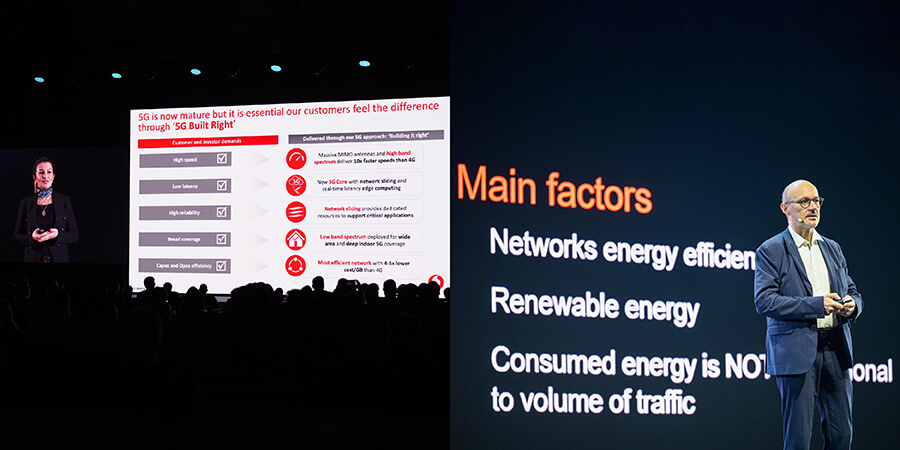During Huawei’s Global Mobile Broadband Forum 2022, Nadia Benabdallah, Vodafone network strategy and engineering director, shared how 5G is built the right way.
She believes that while 5G is now mature, it is essential that customers experience the difference through what she calls “5G Built Right.”
And with the ever-evolving customer demands, such as higher speeds, low latency, high reliability, broad coverage and CAPEX and OPEX efficiency, these will also mean new requirements regarding the networks.
Benabdallah pointed out that building 5G right requires massive MIMO antennas and high band spectrum that deliver 10 times faster speeds than 4G. “So we need to deploy the higher bands to 3.5 gigahertz and not just do the [assessment] because having an icon that says 5G on the phone doesn't mean that you deliver the 5G experience to the end customer.”
Another approach to building 5G right is the new 5G core with network slicing and real-time latency edge computing. She suggests deploying the new core and exploring the possibility of having scenarios that cater to the specific needs of the customer through network slicing.
Network slicing, she explained, also provides dedicated resources to support critical applications.
Moreover, to build 5G the right way, she said that low-band spectrum deployment for wide areas and deep indoor 5G coverage are also needed. “When it comes to broader coverage, [look] at the lower band — the 700 megahertz, which is the newer one. And why not also the other band [which] is 800/900? If we drive, for example, 3G shut down in order to be able to do ‘re-farming’.”
Lastly, another building block is that of 5G, which is the most efficient network with four- to five-times lower cost per GB than 4G. She continued, “And this for us obviously is very important because it allows us to enable the business.”
Benabdallah also stressed the importance of raising the installed capacity. “We have sometimes between 5 and 10% less capacity because of the common channel. We are not raising the capacity. The load [of] our traffic would move up, as you can see in Financial 2025. And already by then, the capacity that 4G can offer will not be sufficient if I add other bands for those operators that have 2.6 gigahertz TDD and 1.4 gigahertz; then you can see that still with that, we will not be able beyond Financial 2025 to actually meet our needs in terms of capacity.”
She added that with the absence of 5G, there will be congestion, and this will reduce the performance provided to the customer.
Also sharing his insights at the MBBF 2022, Emmanuel Chautard, Orange’s senior vice president of operations and network economics, stressed the relevance of green software-based Telco.
He said that the accelerating growth of the ICT industry has also brought environmental consequences. He cited statistics by the French regulator indicating that more than 75% of the carbon emissions are associated with digital devices, whereas the share for network traffic is reduced to 6% for networks overall and 16% for the data centers.
At Orange, Chautard said that they’re focusing on recycling and increasing the lifetime of these devices. “The contribution that we can bring to reduce and to support the other industries is just giving a very high return of investment, if I may say so. In the networks, through efficiency that we can bring to transport, to logistics and features that are supporting also our customers in order to reduce the travels and at the same time to have multiple services in a greener way.”
He noted that they are looking closely at the three scopes of carbon emissions, from the most direct to the more indirect, including those of their subcontractors. Chautard said, “It is comforting to see that, with speed, we have made public commitments in the case of Orange by 2040 to be carbon neutral, ahead of the EU schedule. Depending on the footprints, the activities and the starting point, we see various commitments, but the general move [is] towards net zero carbon.”
Looking ahead, he stated that by 2025, they will already have reached an important milestone in terms of the reduction of carbon emissions versus the 2015 baseline. And they are also considering the overall reduction in power consumption.
As of now, he sees the second great trend happening: the smooth evolution towards a software-based telco and the introduction of software in the ways that they are building networks. He explained that from fully integrated operators, doing everything from infrastructure to the services offered to the customer, they are shifting to what they call the “Julia model,” essentially a multilayer model with an infrastructure layer included.
This softwarization, he said, is based on four pillars: disaggregation, virtualization, automation and on-demand.
Disaggregation means that they are no longer implementing black boxes into their networks, as they did in the past. Instead, they are now identifying the software level, the OS level and the infrastructure level.
Virtualization, meanwhile, is the mutualization of several network functions on the same cloud infrastructure.
With automation, they provide AI machine learning in order to support both the life-cycle management and the in-life management of the network.
And finally, with network services becoming “As a Service” in a real on-demand mode, APIs are also key enablers for this transformation.
He explains the importance of this softwarization: ”It is because we want to be able to offer the on-demand connectivity which our customers are expecting, especially the business customers, which is for Orange business services and important needs and for the carriers as well as the carriers of business, also for some savings that we can perform. So [this means] efficiency — coming from faster deployment and reduction of workloads — through automation as well as time to market.”





